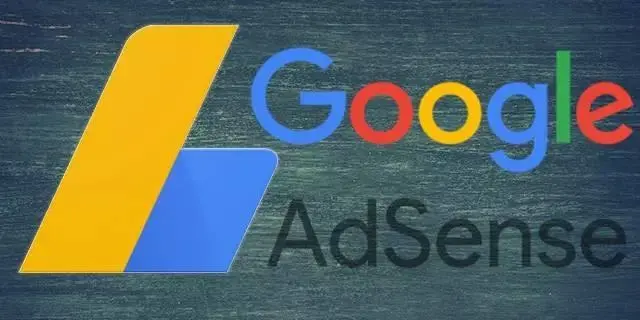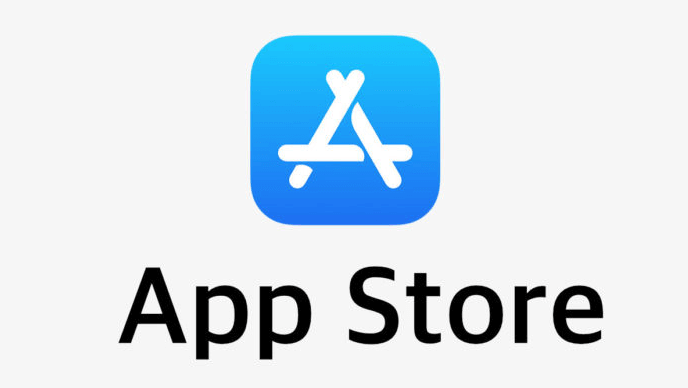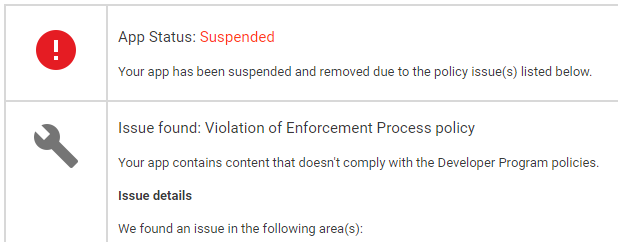In the past year or two, many developers have encountered similar issues with Google Play suspending accounts or removing apps. After putting in so much work, a single account suspension can mean losing all the efforts invested, a significant setback.
However, don’t despair. In this article, we’ll analyze the reasons for suspensions and explore solutions. (This article is lengthy but full of valuable insights, so please read carefully.)
I. Reasons for Account Suspension
Policy Violations: Google Play has strict policies; any app that violates these is at risk of suspension.
User Complaints: High volumes of user complaints may prompt Google to take action.
Security Issues: Security vulnerabilities or malicious behaviors, such as viruses or malware, are common causes of suspension.
Copyright Violations: Using copyrighted content (music, images, videos) without permission can lead to complaints from rights holders and result in suspension.
Privacy Violations: Collecting, using, or disclosing personal information without user consent breaches privacy policies.
False Advertising: Misleading or exaggerated promotional material or descriptions can be considered fraudulent.
Malware: Apps containing malicious software, viruses, adware, or harmful code that threatens device security can lead to suspension.
Rating Manipulation: Unfair practices like incentivizing reviews or manipulating ratings violate fair competition rules.
Local Law Violations: Violating specific regional laws or regulations in the app’s content or functionality.
Technical Issues: Apps with significant technical issues, like frequent crashes, that impact user experience.
II. Preventive Measures
Follow Guidelines: Carefully read and adhere to all Google Play policies and guidelines.
User Communication: Engage with users to understand their needs and address issues promptly.
Security Checks: Regularly test the app for security risks to prevent potential vulnerabilities.
Copyright Compliance: Use only original content or content that has been legally licensed.
Privacy Policy: Clearly outline data collection, usage, and protection measures and ensure compliance with related laws.
Honest Promotion: Ensure that promotional materials and descriptions are accurate and not misleading.
Security Audits: Regularly conduct security reviews and vulnerability scans to keep the app free of harmful code.
Fair Competition: Avoid engaging in rating manipulation or other unfair competitive practices.
Legal Compliance: Understand and comply with local laws in the app's target markets.
Technical Optimization: Continuously optimize app performance for stability and enhanced user experience.
User Feedback: Implement a robust feedback mechanism to address user concerns and suggestions quickly.
Multi-Platform Strategy: Consider releasing apps on multiple platforms to reduce reliance on a single platform.
Continuous Learning: Stay updated with Google Play policy changes and adjust app strategies to prevent violations.
III. Strategies for Reinstatement
Appeal: If you believe the suspension was a mistake, you can appeal through Google Play’s channels.
App Modification: Address issues flagged by Google, make necessary adjustments, and resubmit.
Multi-Channel Distribution: Avoid putting all resources into one platform and consider publishing on others to mitigate risks.
Understanding Suspension Reasons: Review Google’s email for specific reasons and details regarding the suspension.
Appeal Process:
Prepare Documentation: Gather relevant appeal materials, like copyright proof, privacy statements, and user feedback.
Submit Appeal: Use Google Play’s appeal channel to clearly explain your case with supporting documentation.
App Adjustments:
Problem Resolution: Resolve and optimize issues identified by Google.
Testing Verification: Thoroughly test the app to ensure all issues are fixed before resubmission.
Communication:
User Communication: If suspension impacts user experience, communicate promptly with users, explain the situation, and provide an estimated resolution time.
Google Communication: Keep Google Play’s communication channel open to receive updates on the appeal progress.
Legal Consultation: If legal issues arise, consider consulting a professional to ensure compliance during the appeal process.
Backup Plans: During appeal and adjustment, explore alternative platforms or channels to minimize operational losses.
Public Relations: If the suspension gains public attention, handle PR appropriately to maintain brand image.
Transparency: Maintain transparency throughout the reinstatement process with both users and Google.
Continuous Monitoring: After reinstatement, monitor the app’s performance and user feedback to prevent recurrence.
Policy Updates: Stay informed about Google Play policy updates to keep the app compliant with the latest requirements.
Community Support: Leverage the developer community for insights and to help other developers.
The most severe reason for account suspension often relates to account association, so focus on prevention and reviewing all account association details.
IV. Operations and Testing
Developer Account
Use a clean Gmail account. (Refer to my previous article, “How to Properly Register a Google Account?”)
Phone Number: Long-term overseas real-name number > Non-real-name overseas number > Virtual number > Domestic number
Name (for verification)
Backup Email
Credit Card: Overseas > Virtual > Domestic
Bank Account
Address Information
Account Age
Login Details
Device System Info:
Phone UUID, IMEI, Model
Computer: Browser cookies; RAM, hard drive, CPU (virtual machine configurations)
IP, Location, System Language, and Unique Account Info
Store Details
Images: Five promotional images (1024 x 500)
Icon
Description
Privacy Policy
Test Account
In-app Product IDs
Contact Information
Payment Info
V. Technical/Advertising-Related Aspects
External to App
Facebook:
Fan Page
App ID
Third-Party SDKs: Appflyers/Adjust for attribution
Google Ecosystem
AdMob
Firebase
Google Ads
Packaging Devices
Device Signatures: One app per device, per signature
AAB (APK)
For alternative packages, avoid code similarity with previous submissions since Google performs static detection. Avoid using the same AAR files; change package or class names, and use third-party tools for security.
Game Resources
Encrypt asset bundles to avoid too many binary files being exposed in the assets/bin/Data directory.
Summary
Navigating Google Play’s account suspension challenges requires robust preventive strategies across all aspects, from independent registration details to isolated device information and innovative technical solutions.
By proactively managing risks—whether through unique phone numbers, independent credit cards, or updated server configurations—developers can protect their accounts. Regular checks, code updates, resource encryption, and careful third-party SDK use also help avoid association issues.
Stay informed of Google Play policy updates and adjust strategies accordingly to maintain compliance, ensuring the success of your app on Google Play.





